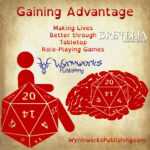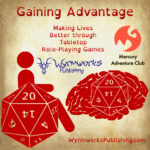How to Succeed in Tabletop Roleplaying Game Publishing
In September 2020, I left my 22-year career with no prospects. I picked up a temporary day job to pay the bills and provide health insurance, but in July 2021, I left that job to focus on roleplaying game development full-time. I didn’t have much to lose, since my day job wasn’t paying enough to sustain my family, but it was still a risk — something is better than nothing. I stepped into uncharted territory with a plan to launch a Kickstarter to get the business off the ground, but as an Enneagram Type 3 personality, I’m terrified of failure, so I was plagued by the question, “Will I succeed?” And not only do I consider myself already successful, but I believe I’ve learned how to do that, and in an industry where every challenge seems to be mythic, where the monster, once slain, rises again stronger than ever, it might be helpful to share my insights, as my road has been unlike most in this field.
Note: I’m presenting these observations and tips as a publisher, not a freelancer. It’s important that you decide which you want to be as you start out. If you start as a freelancer and don’t start building an audience right away, you’ll have some makeup work to do if you decide you want more control over your work. But publishing requires a lot of work that’s not just creating.
Choose Your Class
The three pillars of any RPGs are exploration, social, and combat. In TTRPG publishing, the tiers follow a similar pattern.
Exploration. Search yourself. What are your passions? What is your niche? What do you love creating? What mark do you want to leave on the hobby? What niche would you love to spend the next few years learning about, exploring, and working on?
Social. Find your audience. What niche is underserved? What are people requesting that isn’t available? It could be a topic, a unique combination of topics, or a new product. Maybe people want jellyfish-themed subclasses or feather dusters that look like phoenixes or cockatrices.
Combat. Where’s your proficiency? When you get to work, what are you good at? What do you have a knack for? Are you a wordsmith, an artist, a crafter, a speaker…what rolls do you have bonuses on?
Now find where all three of those overlap. You need the skill to make something valuable, or you won’t get compensated for your work. You need an audience that wants what you’re creating, even if they don’t know it yet, but it’s definitely easier if they know and are looking for it already. And you need passion, or it’ll get boring fast, and you don’t want to turn your hobby into a business only to get bored.

Find Your Allies
Thanks to recent events, my belief about this industry has been solidly confirmed that, just as TTRPGs are cooperative games, not competitive, the same is true of the TTRPG publishing industry. “A rising tide raises all ships.” Consequently, the most effective form of marketing in the TTRPG industry is cross-promotion.
So make friends. Find people who share your passions and your niche. But don’t stop there. Gamers often have eclectic tastes, so don’t limit your social circles. At the same time, by making friends whose lives and interests are different, you’ll expand your awareness, empathy, and creativity.
As you expand your social circle, start talking to your friends about cross-promotion. Or just promote their stuff without expectation of reciprocation. Just be a good friend. Over time, each of you will help each other, you’ll expose your audience to new products, and your audience will grow at the same time.

Start Your Quest

When I started, I thought I needed Twitter to build my audience. I met some cool people there before I moved to Mastodon, but the return on the time investment would have been better spent elsewhere. Here’s how to get started without Twitter:
- Learn the Craft. Publishing a supplement is more detailed than creating an adventure or homebrew for your home game. Each game system requires certain standard syntax. Learn those phrases. Get involved in an online community like /r/UnearthedArcana/. Take the Write Your First Encounter course from the Storytelling Collective — it’s worth the cost.
- Put some small free creations on DriveThruRPG. This is the easiest way to build an audience. If you start with free, people will try your work, and you’ll be able to email about half of them with future announcements. If writing is your specialty, not layout, find a template for Word or use GM Binder or Homebrewery for design, and use public domain art.
- Create some slightly larger projects, and charge for them. (Don’t make them Pay What You Want. There’s no benefit to that.)
- Meanwhile, start thinking about a Kickstarter, a project big enough to make it worth the platform, but it doesn’t need to be huge. A 30-page adventure, collection, or other supplement using stock art will get you started, and a low price tier for the digital format will encourage people to try your work with minimal risk. The goal of this project is less about income and more about number of backers. Use DriveThruRPG to fulfill at least the digital product, and they will allow you two emails to your customer list. And then when your backers get their finished product, they’ll be added to your email list there. Meanwhile, when you send out surveys at the end of your project, offer the opportunity to join an external email list, like Mailchimp’s free email tier. (Note: Mailchimp recently drastically reduced their free tier subscriber limit. You can start there, but you’ll need to move to something else quickly, so shop around.)
- By the time you finish your first Kickstarter, you’ll have three ways to contact your audience: DriveThruRPG, Kickstarter backer updates, and your email list. Each has a different focus, so be careful how you use each one, and respect each group.
- Repeat the process, adding collaborators to build larger products (or keep doing small ones if you want!), and you’re well on your way.
Keep Leveling Up
Part of the benefit of collaborating means learning. Use editors and sensitivity readers. They will help you learn how to make a better product. Hire extra writers, and learn from their styles. Get on Discords with other creators to improve your craft. Ask your peers to look at your works in progress, and invite feedback.
Don’t Forget Downtime

Merging hobby with career is wonderful, but you still have to account for exhaustion. Running a business doesn’t typically have “office hours,” since the to-do list grows faster than you can check items off, and I typically find myself working 50+ hours/week, and my mind is often on work when it should be on family.
Find another hobby. I set goals to read a certain number of comic books via my Marvel Unlimited subscription each week. It allows me to relax and feed my creativity with a different medium and genre than high fantasy TTRPG.
Invest in your values. Think about what’s most important to you. For me, it’s my Christian faith and my family. If I want both of those to grow stronger, I need to invest time in them. For me, that means blocking out time on my calendar for those priorities and sticking with them. Thankfully, my wife loves me dearly and won’t let me neglect those values. If your time use doesn’t reflect your values, consider asking someone to hold you accountable to your own goals. I use RescueTime to set productivity goals, but it also helps me limit my work.
It’s a Game. If it’s not fun, you’re doing it wrong.
Tying back to the first point, TTRPGs are amazing, but publishing has major challenges. It won’t always be fun, but check with yourself — when it’s time to start your work, are you excited or dreading it? That can change depending on the day’s plans, but how do you feel about it overall? If you start to dread it, you may want to consider a different field or at least a different approach. Maybe you need to hire people to take some of the drudgery from you. As I often tell my children, “Make choices that give you what you want.”
What I wish I knew before I started
Finally, here’s a few tips I learned along the way that might be helpful to someone:
- VAT: If you use DriveThruRPG for fulfillment, they handle VAT and other international details. If you don’t live in the EU, it’s almost impossible to ship physical products there due to VAT unless you work through a distributor. Especially when you’re just starting out, using their Print on Demand service is invaluable.
- Proofread your updates: You can edit updates for up to 30 minutes after you post them, but most backers read it in their email, so they won’t see the typos you fixed. I sent out 2 updates with subject lines that said our pre-order store was open when it wasn’t yet, because I thought it would be when I started the message, but then plans changed, and I forgot to edit the subject.
- Figure out how you’re going to handle pledge management in advance. Contact the company you’re planning to use. Get it set up and ready to launch as soon as possible, preferably shortly after you launch your campaign. Know how to import your backers into it. I tried importing my backers into Gamefound, and while adding people was easy, I gave up trying to import their pledges in a form that worked with our campaign.
- Marketing isn’t evil. It’s just letting people know about the cool stuff you’re making so they don’t miss it. Even though Limitless Heroics had 2300 backers, more people keep finding it. Our website continues to get significant traffic from Kickstarter, even though the campaign ended a year ago. The more we get the word out, the more people who want this will know it exists. Just be honest.
- Twitter is lousy for marketing. I can count on one hand the number of people in this industry who have built a publishing business using Twitter as their primary marketing platform, and they all spent thousands of hours there interacting, and even then, the number of paying customers to followers is minuscule. Twitter is useful for freelancers, because it’s about building relationships, not topics, and the algorithm demotes offsite links. But no matter what social media platforms you use, email is still king and the most effective way to connect with those interested in your work..
- DriveThruRPG’s 2 PoD options have significant pros and cons. When I launched the Limitless Heroics Kickstarter, I had no idea how it would be received, whether anyone would want it, so I chose their voucher system that didn’t include the print cost in the backer tier. It was the lowest risk, but it led to a lot of confusion. I still get frustrated backer comments and messages about it. If you’re not sure about your project’s popularity or plan to allow for a lot of backer-submitted content or stretch goals that could increase the page count, this insures that print costs don’t outweigh backer tier amounts, but be prepared to answer a lot of questions after the campaign when it’s time for fulfillment, and be very clear about how this works in advance, repeating it frequently. Also, the boilerplate messaging that OneBookShelf offers for this process is confusing. Here’s my suggestion to reword it, but IANAL.
This campaign offers a digital copy as the main reward. However, backers can also pay extra after the campaign to get a discounted physical printed version of the book or cards through OneBookShelf’s Print-On-Demand (POD) service. The POD version will become available to order after the digital version has been completed. Backers will receive a link to purchase the discounted POD version from OneBookShelf.
So, what’s your TTRPG publishing journey like? Share your thoughts in the comments below!











 Get 10 Free Adventures
Get 10 Free Adventures
Comments
How to Succeed in Tabletop Roleplaying Game Publishing — No Comments
HTML tags allowed in your comment: <a href="" title=""> <abbr title=""> <acronym title=""> <b> <blockquote cite=""> <cite> <code> <del datetime=""> <em> <i> <q cite=""> <s> <strike> <strong>